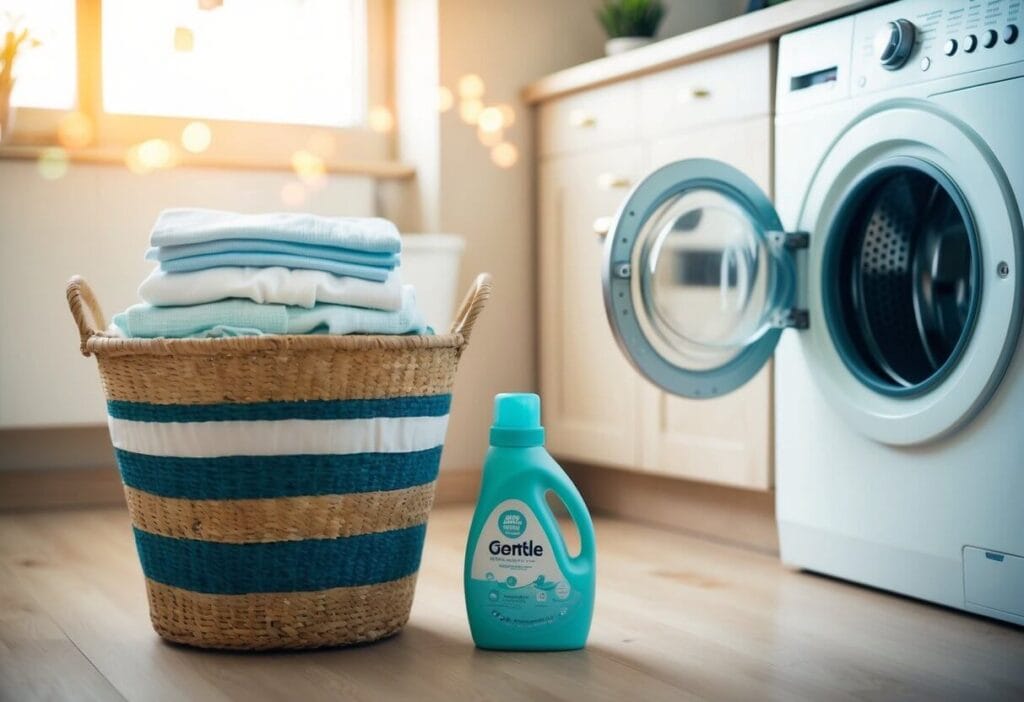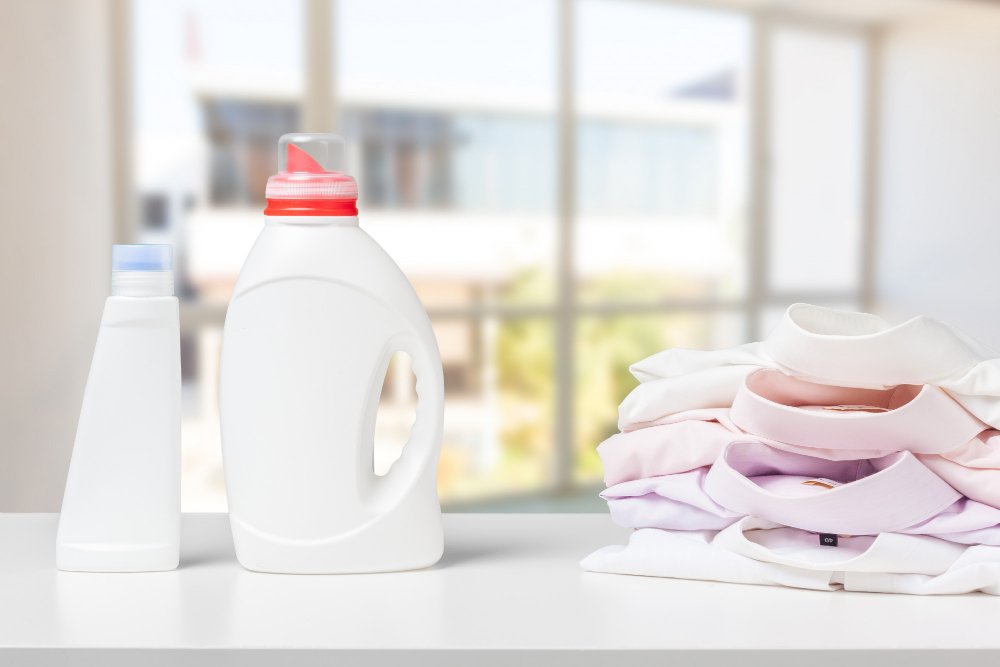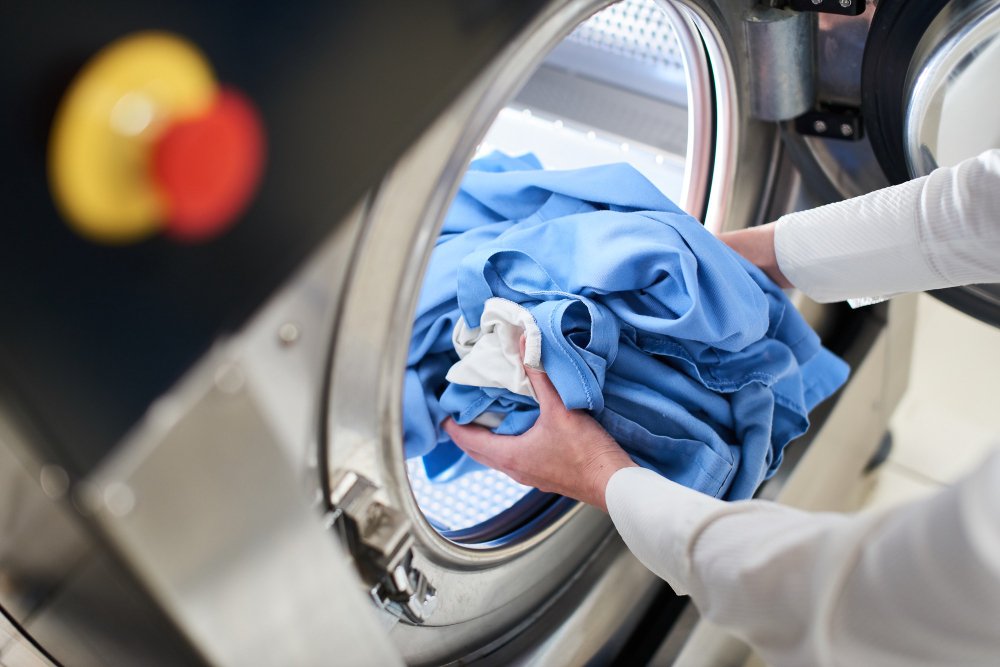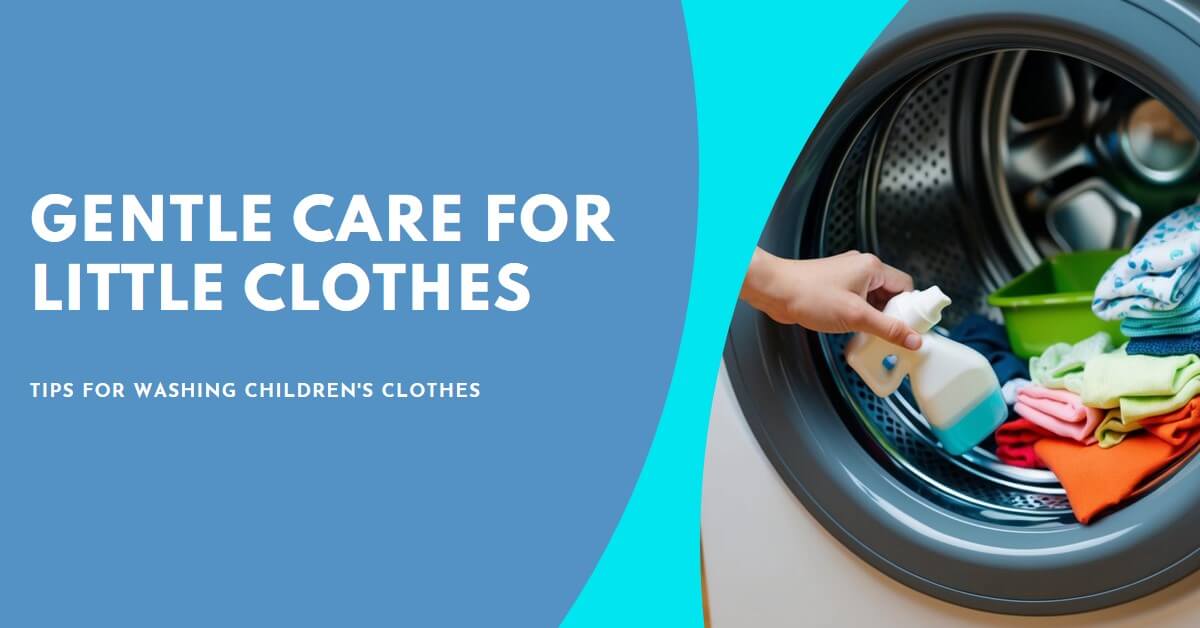Essential Tips for Busy Parents
Washing children’s clothes can seem like a daunting task, especially for new parents. I’ve been there, and I know how important it is to keep those tiny outfits clean and safe for your little one’s sensitive skin. The key to washing children’s clothes is to use a gentle, non-biological detergent and wash them separately from adult clothes.
I’ve found that sorting clothes by colour and checking care labels before washing is crucial. Light and dark colours should be washed separately to prevent colour bleeding. It’s also wise to wash any items that have come into contact with nappies or sick at a higher temperature to ensure proper cleaning.
When it comes to drying, you have options. You can either use a tumble dryer on a low heat setting or hang the clothes to air dry. Both methods work well, so choose what’s most convenient for you. Remember to always check the care labels for specific drying instructions.
On This Page
Key Takeaways
- Use a gentle, non-bio detergent and wash children’s clothes separately
- Sort clothes by colour and check care labels before washing
- Choose between tumble drying on low heat or air drying for best results
Preparing to Wash Baby Clothes

Getting ready to wash baby clothes involves a few key steps. I’ll guide you through checking labels, sorting items, and dealing with stains to ensure your little one’s clothes come out clean and fresh.
Checking Labels and Instructions
I always start by reading the care labels. These tiny tags have crucial info about washing temperatures and methods. Some baby clothes need special care, like flame-resistant sleepwear that shouldn’t be washed with fabric softener.
I look out for symbols that show if an item can go in the dryer or needs to air dry. For delicate pieces, I might see a ‘hand wash only’ label. If I’m unsure, I stick to a cool wash and gentle cycle to be safe.
It’s best to follow these instructions closely. Baby skin is sensitive, and proper washing helps keep clothes soft and safe for wear.
Sorting Baby Clothes
Next, I sort the clothes. This step is vital for keeping everything in top shape. I separate whites from colours to prevent dye transfer. Light pastels go with whites, while bright colours and darks form their own piles.
I also group similar fabrics together. Soft cottons can be washed on a gentle cycle, while tougher items like denim might need a stronger wash.
Items with heavy soiling, like nappies or clothes with sick on them, get their own pile. These need a hotter wash to kill germs.
Pre-Treatment of Stains
Stains are a fact of life with babies. I tackle them before they set in. For milk or formula spots, I rinse with cold water right away. Food stains get a quick dab with a baby-safe stain remover.
I’m careful with poo stains. First, I scrape off any solid bits. Then I soak the item in cold water with a touch of stain remover. For stubborn marks, I might use a soft brush to work the cleaner in gently.
Oily stains from creams or lotions need a different approach. I dab these with a bit of dish soap before washing. This helps break down the oils.
Choosing the Right Detergent

Picking the proper detergent is key for washing children’s clothes. I’ll cover gentle options for sensitive skin and hypoallergenic choices without fragrances.
Detergents for Sensitive Skin
I recommend using a gentle liquid detergent made for kids’ clothes. These are milder than regular detergents. They clean well but don’t have harsh chemicals that can bother a child’s skin.
Look for products labeled “baby detergent” or “for sensitive skin”. These often use plant-based cleaning agents. They’re less likely to cause rashes or irritation.
I suggest trying a small amount first to check for any reactions. Some good options are Fairy Non-Bio or Ecover Zero. These clean effectively even in cool water.
Hypoallergenic and Fragrance-Free Options
For extra-sensitive kids, I advise picking hypoallergenic and fragrance-free detergents. These have fewer ingredients that might trigger allergies.
Avoid detergents with strong scents or dyes. Even natural fragrances can cause problems for some children.
Good choices include Persil Non-Bio or Surcare. These clean well without leaving behind irritating residues.
I also suggest double-rinsing clothes to remove all soap traces. This extra step can help prevent skin issues in sensitive kids.
Washing Process and Techniques

Proper washing techniques keep children’s clothes clean and in good condition. I’ll cover key steps for machine washing, hand washing delicates, and using fabric softeners safely.
Machine Washing Settings
I always start by sorting clothes by colour and fabric type. For most children’s clothes, I use a normal cycle with cold water (30°C) or warm water (40°C). Cold water works well for dark colours and delicates. Warm water is better for whites and heavily soiled items.
I choose the right detergent – liquid works best for cold washes. I measure carefully to avoid residue. For baby clothes, I use a gentle, fragrance-free detergent.
I set the load size to match the amount of laundry. Overloading can prevent clothes from getting clean. I close zips and buttons to prevent snagging.
Hand Washing Delicate Items
Some children’s items need hand washing. I fill a sink with cool water and add a small amount of mild detergent. I gently swish the garment, paying extra attention to stained areas.
I rinse thoroughly in cool water until all soap is gone. To remove excess water, I press the item against the sink – never wring or twist.
I lay delicate items flat to dry, reshaping as needed. For wool, I use a clean towel to roll and press out water before laying flat.
Using Fabric Softeners
Fabric softeners can make clothes feel softer, but I use them sparingly on children’s clothes. They can reduce the absorbency of towels and nappies.
I never use fabric softener on flame-resistant sleepwear – it can affect the treatment. For other items, I add a small amount to the designated compartment in the washing machine.
For sensitive skin, I skip fabric softener or use a hypoallergenic option. White vinegar in the rinse cycle can soften clothes naturally without chemicals.
Drying and Finishing Touches
Proper drying and care are key for keeping children’s clothes in top shape. Let’s look at the best ways to dry and store baby clothes.
Drying Options for Baby Clothes
I always check labels before drying baby clothes. Many items can go in the tumble dryer on low heat. But some need to air dry to avoid shrinking or damage. For delicates, I lay them flat on a towel or use a drying rack.
When using the dryer, I add a clean tennis ball. This helps fluff up clothes and cut drying time. I never use dryer sheets, as they can irritate a baby’s skin.
For air drying, I hang items outside on sunny days. The UV rays help kill germs. On rainy days, I use an indoor rack near a fan or open window.
Folding and Storing Clothes
I fold baby clothes right after drying to avoid wrinkles. Small items like socks go in mesh bags to keep pairs together. I sort clothes by size and type for easy access.
For storage, I use plastic bins with tight lids. This keeps out dust and pests. I label each bin by size and season. Clothes that are too big go in higher shelves until needed.
I hang special outfits on small hangers to keep their shape. Delicate items get tissue paper to stop creases. For long-term storage, I use vacuum bags to save space.
Clean, dry drawers are best for daily-use items. I line them with scented paper for a fresh smell. Every few months, I rotate clothes to make sure nothing gets forgotten at the back.
Additional Considerations
When washing children’s clothes, there are a few extra things to keep in mind. I’ll cover some key points about handling newborn garments, dealing with reusable nappies, and avoiding skin irritation.
Washing Newborn Clothes
Newborn clothes need special care. I recommend washing them before the first use to remove any leftover chemicals or dust. Use a mild, fragrance-free detergent made for babies. Wash new items separately from the rest of the laundry.
Don’t use fabric softeners on newborn clothes. They can leave a residue that might bother a baby’s sensitive skin. Instead, try adding a cup of white vinegar to the rinse cycle. This helps soften clothes naturally.
For tough stains like milk or spit-up, I soak the item in cold water right away. Then I apply a bit of baby-safe stain remover before washing. Hot water can set protein-based stains, so I use warm or cool water for most newborn laundry.
Managing Reusable Nappies
Reusable nappies need a bit more work, but they’re better for the environment. I rinse them in cold water after use to remove solid waste. Then I store them in a dry pail until wash day.
I wash nappies every 2-3 days to prevent odours and stains from setting. Here’s my process:
- Pre-wash in cold water
- Main wash in hot water (60°C) with baby-safe detergent
- Extra rinse to remove all soap
I don’t use fabric softeners on nappies. They can reduce absorbency. To dry, I hang them outside when possible. Sunlight helps remove stains and kill germs.
Avoiding Skin Irritation
Babies have delicate skin that’s easily irritated. I always choose a mild, unscented detergent made for sensitive skin. I use the least amount needed to clean the clothes properly.
I wash new clothes before use to remove sizing chemicals. These can cause rashes on some babies. I also make sure to rinse clothes well. Leftover detergent can bother a baby’s skin.
For babies with very sensitive skin, I might need to double rinse their clothes. I also avoid using dryer sheets, which can leave irritating residues. Instead, I use dryer balls to soften clothes and reduce static.
Frequently Asked Questions
How should you wash kids’ clothes?
When washing kids’ clothes, always check the care labels first for any special instructions.
Generally, use a mild detergent that’s gentle on sensitive skin. It’s best to use a cold or warm water cycle, depending on the fabric, to prevent shrinking or fading. Also, pre-treat stains (which we all know kids’ clothes are prone to) before washing to ensure they come out clean.
Should you wash kids’ clothes separately?
It’s not always necessary to wash kids’ clothes separately from the rest of the family’s laundry, but it can be a good idea if your child has sensitive skin or allergies.
Baby clothes, in particular, should be washed separately to avoid exposure to harsh detergents or residues from adult clothing.
Is it okay to wash baby clothes in the washing machine?
Yes, it’s perfectly fine to wash baby clothes in the washing machine, but use a gentle cycle and a baby-friendly detergent that’s free from dyes and fragrances.
Avoid using high temperatures unless you’re dealing with heavily soiled or cloth nappies, as hot water can be too harsh for delicate fabrics.
What is the best cycle to wash kids’ clothes?
The best cycle for washing kids’ clothes depends on the fabric and level of soiling. For everyday clothes, a cold or warm delicate cycle works well.
Heavily soiled play clothes or those with tough stains may need a longer wash on a regular cycle with pre-treatment.
Is it better to wash baby clothes at 30 or 40?
For most baby clothes, washing at 30°C is sufficient and gentler on the fabric, helping them last longer. However, if the clothes are heavily soiled or you’re washing cloth nappies, a 40°C wash can help remove bacteria and tough stains more effectively.
Is it okay to wash kids’ clothes with adult clothes?
Yes, you can wash kids’ clothes with adult clothes, provided both are being washed with a gentle detergent suitable for sensitive skin.
If you’re washing clothes for a baby or toddler, you may still want to wash them separately, especially if the adult clothes are heavily soiled or contain harsh detergents.
What is the correct order of doing laundry?
The correct order of doing laundry generally follows these steps:
• Sort clothes by colour and fabric (whites, darks, colours, and delicates).
• Check care labels for specific washing instructions.
• Pre-treat stains before placing items in the washing machine.
• Choose the appropriate detergent and settings for the load.
• Dry clothes according to the fabric (tumble dry or air dry).
• Iron or fold once dry, if necessary.
Should you wash kids’ clothes inside out?
Yes, washing kids’ clothes inside out is a good practice, especially for printed or embroidered items. This helps protect the designs from fading or cracking.
It can also reduce wear and tear on the outer fabric, making the clothes last longer.
Do you use fabric softener on baby clothes?
It’s generally recommended to avoid fabric softener for baby clothes, as it can leave a residue that might irritate sensitive skin.
Some fabric softeners also reduce the absorbency of certain fabrics, like towels or cloth nappies, which is something you want to avoid.

